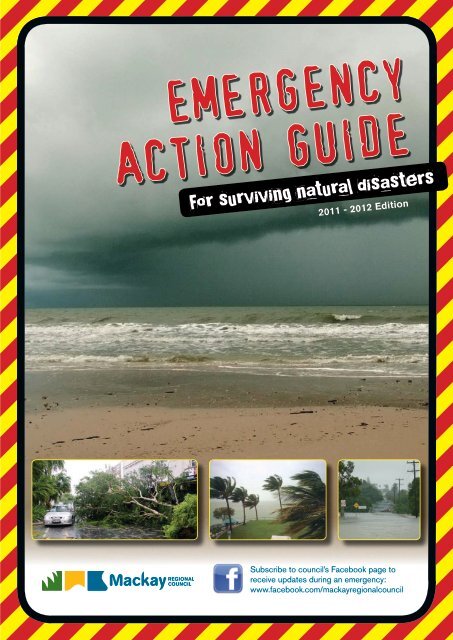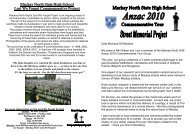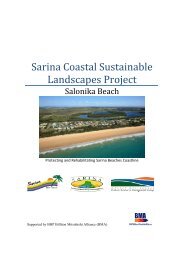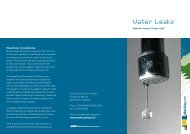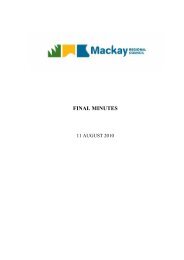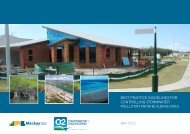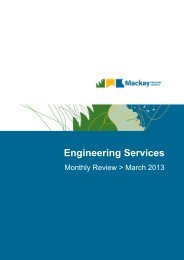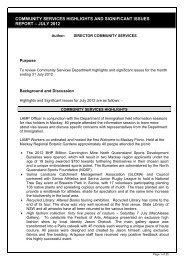Emergency Action Guide - Mackay Regional Council
Emergency Action Guide - Mackay Regional Council
Emergency Action Guide - Mackay Regional Council
You also want an ePaper? Increase the reach of your titles
YUMPU automatically turns print PDFs into web optimized ePapers that Google loves.
EMERGENCY<br />
ACTION GUIDE<br />
For surviving natural disasters<br />
2011 - 2012 Edition<br />
Subscribe to council’s Facebook page to<br />
receive updates during an emergency:<br />
www.facebook.com/mackayregionalcouncil
authority<br />
This <strong>Emergency</strong> <strong>Action</strong> <strong>Guide</strong> has been produced by the <strong>Mackay</strong> Local Disaster Management Group as<br />
an annexure to the <strong>Mackay</strong> Local Disaster Management Plan (A requirement of the Disaster Management<br />
Act-2003.)<br />
Each year from November to May, our region is in its cyclone season. It is important to remain vigilant and be<br />
prepared for emergency situations such as cyclones, storm surge, floods, major urban and rural fires, industrial<br />
accidents/hazardous material accidents/spills, etc.<br />
introduction<br />
Local Government in the <strong>Mackay</strong> Region has always and will continue to play a critical role in emergency<br />
management. Flooding and tropical cyclones are an inevitable part of living in the tropics and you cannot<br />
afford to become complacent about the dangers they present.<br />
To assist you in preparing for such events and to protect yourself and your family, this <strong>Action</strong> <strong>Guide</strong> has been<br />
produced for the <strong>Mackay</strong> <strong>Regional</strong> <strong>Council</strong> area.<br />
Please take the time to read it, and then store it where it is readily accessible.<br />
This <strong>Action</strong> <strong>Guide</strong> is an update to the previous releases and contains storm surge inundation maps<br />
produced in accordance with the current State Government Mapping <strong>Guide</strong>lines.<br />
Please note that the <strong>Mackay</strong> <strong>Regional</strong> <strong>Council</strong> does not have certified shelters available for use during a<br />
cyclone and you should pre-arrange your self-evacuation in preparation, should the authorities order you to do so.<br />
People are required to self-evacuate if ordered, however if you or someone<br />
you know, are unable to do so due to a special need (wheelchair reliant,<br />
house bound etc.) and have no relatives or friends who can assist -<br />
YOU SHOULD REGISTER WITH COUNCIL NOW.<br />
Call the Customer Service Centre on 1300 622 529<br />
> contents<br />
Cyclones.................................................... 1<br />
Cyclone Categories................................... 2<br />
Cyclone: Important Phone Numbers....... 2<br />
Surviving Cyclones................................... 3<br />
Cyclone Preparation Checklist................ 4<br />
Flooding..................................................... 5<br />
Evacuation................................................. 6<br />
What is a Storm Surge.............................. 7<br />
Storm Surge Inundation Maps...................<br />
Evacuation Zone Purple......................... 8 - 9<br />
Evacuation Zone Grey.........................10 - 11<br />
Evacuation Zone Orange................... 12 - 13<br />
Evacuation Zone Pink........................ 14 - 15<br />
Evacuation Zone Brown..................... 16 - 17<br />
Outlying Communities................................<br />
Evacuation Zones............................... 18 - 26<br />
Electrical Safety....................................... 27<br />
Cyclone Safety......................................... 28<br />
Industrial/Chemical Spill Accident......... 29<br />
Urban and Rural Fires............................. 29
140°E<br />
CYCLONES<br />
Tropical Cyclones are the most severe storms with strong winds, heavy rain and ocean<br />
storm surge, which have the potential to cause extensive property damage. Cyclones vary<br />
greatly in character but the one feature they all have in common is a calm centre. This centre<br />
or “eye” is an area made up of light winds and often-clear skies.<br />
However beware, this is not the end of the cyclone as very destructive winds from the other<br />
direction can follow. Remain inside until it has passed.<br />
The cyclone season extends from around November to May.<br />
!<br />
Thursday Is<br />
!<br />
Orford Ness<br />
145°E<br />
150°E<br />
155°E<br />
cyclone tracking map<br />
160°E<br />
10°S<br />
IMPORTANT<br />
Listen to your<br />
radio; heed all<br />
warnings and<br />
advice.<br />
Cyclone Yasi<br />
Category 5 crossed<br />
near Innisfail in<br />
February 2011<br />
causing 5m storm<br />
surge on a falling<br />
tide, and 2.3m<br />
inundation above<br />
king tide level at<br />
Cardwell.<br />
Note: Gale force<br />
wind speeds of about<br />
70kph were recorded<br />
in <strong>Mackay</strong>.<br />
F<br />
A R I A<br />
! Mapoon<br />
! Weipa<br />
! Aurukun<br />
! Cape Keerweer<br />
! Pormpuraaw<br />
! Kowanyama<br />
! Cape Grenville<br />
! Lockhart River<br />
! Coen<br />
! Cape Melville<br />
! Cape Flattery<br />
! Cooktown<br />
C O R A L<br />
S E A<br />
15°S<br />
Cyclone Anthony<br />
Category 2 crossed<br />
near Bowen in<br />
January 2011 causing<br />
minor damage to the<br />
<strong>Mackay</strong> region.<br />
Mornington Is<br />
! Burketown<br />
madgee<br />
! Mount Isa<br />
140°E<br />
!<br />
!<br />
Gilbert River Mouth<br />
Karumba<br />
! Normanton<br />
!<br />
Croydon<br />
!<br />
Georgetown<br />
! Cape Tribulation<br />
! Port Douglas<br />
!<br />
Mareeba<br />
Green Is<br />
! ! Cairns<br />
! Chillagoe<br />
! Atherton<br />
! Innisfail<br />
When a cyclone<br />
advice is issued, the<br />
position of the cyclone<br />
! Longreach<br />
is given as a longitude<br />
and latitude reading.<br />
You can track the<br />
cyclone’s route by<br />
plotting the longitude<br />
(vertical lines) and<br />
latitude (horizontal<br />
lines) on this map.<br />
! Cardwell<br />
! Lucinda<br />
!<br />
Ingham<br />
CYCLONE ADVICES<br />
145°E<br />
!<br />
!<br />
! Townsville<br />
! Ayr<br />
Bowen<br />
!<br />
Charters Towers<br />
! Hayman Is<br />
! Proserpine<br />
! Charleville<br />
!<br />
Holmes Reef<br />
!<br />
Clermont<br />
!<br />
!<br />
Moranbah<br />
Emerald<br />
!<br />
Flinders Reef<br />
!<br />
!<br />
! Sarina<br />
Roma<br />
St George<br />
! Willis Is<br />
MACKAY<br />
St Lawrence<br />
! ! Shoalwater Bay<br />
150°E<br />
!<br />
Yeppoon<br />
!<br />
! Rockhampton<br />
! Heron Is<br />
! Gladstone<br />
! Town of 1770<br />
! Biloela<br />
! Sandy Cape<br />
! Monto ! Bundaberg<br />
! Hervey Bay<br />
!<br />
!<br />
Maryborough<br />
Gayndah<br />
! Double Is Pt<br />
! Gympie<br />
! Tewantin<br />
! Kingaroy<br />
Cape Moreton<br />
!<br />
Dalby<br />
!<br />
Toowoomba ! !<br />
! Point Lookout<br />
!<br />
Brisbane<br />
Ipswich<br />
! Southport<br />
Warwick Coolangatta<br />
!<br />
Goondiwindi<br />
! Cape Byron<br />
! Ballina<br />
These can be issued as a “Watch” or “Warning”. These advices provide information on where<br />
the cyclone is, its movement, how strong it is and identify the areas that could be affected.<br />
A Cyclone Watch is issued every six hours when there are indications that strong winds are<br />
expected to affect coastal/or island communities within 48 hours.<br />
A Cyclone Warning is issued every three hours as soon as gales or stronger winds are<br />
expected to affect coastal or island communities within 24 hours. Forecasts of heavy rainfall,<br />
flooding and abnormally high tides are included where necessary.<br />
!<br />
!<br />
Stanthorpe<br />
0 50 100 200 300 400<br />
Kilometres (Approximate)<br />
155°E<br />
N<br />
160°E<br />
20°S<br />
25°S<br />
Cyclone Ului<br />
Category 3 crossed<br />
near Proserpine in<br />
March 2010, causing<br />
major damage to the<br />
<strong>Mackay</strong> region.<br />
Cyclone Hamish<br />
Category 5 narrowly<br />
missed <strong>Mackay</strong> in<br />
March, 2009.<br />
Tropical Cyclone<br />
Larry struck Innisfail<br />
in March 2006.<br />
The Category 4 storm<br />
caused widespread<br />
destruction.<br />
<strong>Mackay</strong> experienced<br />
a devastating<br />
Cyclone in 1918,<br />
which caused<br />
widespread<br />
destruction and<br />
claimed 30 lives.<br />
Keep calm,<br />
stay inside.<br />
1
CYCLONE Cyclone CATEGORIES Categories<br />
Category:<br />
Strongest Wind Gust<br />
Typical Effect - indicative only<br />
1<br />
less than 125 km/hour<br />
Minor house damage.<br />
Damage to some crops, trees and caravans.<br />
Small craft may drag moorings.<br />
2<br />
125-170 km/hour<br />
Minor house damage.<br />
Significant damage to signs, trees, caravans.<br />
Heavy damage to crops. Risk of power failure.<br />
Small craft may break moorings.<br />
3<br />
170-225 km/hour<br />
Some roof and structural damage.<br />
Some caravan destruction.<br />
Power failure likely.<br />
4<br />
225-280 km/hour<br />
Significant roof loss and structural damage to buildings<br />
Caravans destroyed.<br />
Dangerous airborne debris.<br />
Widespread power failure.<br />
5<br />
greater than 280 km/hour<br />
Extremely dangerous with widespread destruction.<br />
Only in life threatening emergencies should the 000 number be used.<br />
IMPORTANT PHONE NUMBERS<br />
DISASTER CO-ORDINATION CENTRE (when activated)..................................4951 2466<br />
EMERGENCY – Police/Fire/Ambulance…………………………………………………................... 000<br />
EMERGENCY – Electricity (Ergon Energy)........................................................................... 131 670<br />
Faults – Ergon Energy............................................................................................................ 132 296<br />
State <strong>Emergency</strong> Service....................................................................................................... 132 500<br />
<strong>Mackay</strong> Police Station........................................................................................................ 4968 3444<br />
Queensland Ambulance Service............................................................................................ 131 233<br />
Fire Brigade (City).............................................................................................................. 4944 8000<br />
(North <strong>Mackay</strong>).............................................................................................. 4965 6671<br />
(Sarina).......................................................................................................... 4956 1607<br />
Rural Fire Service............................................................................................................... 4965 6641<br />
2
Surviving SURVIVING Cyclones<br />
CYCLONES<br />
When you hear a cyclone warning issued please assist other people<br />
by passing the information onto neighbours and visitors who may not<br />
have heard it or may not have understood the meaning.<br />
STEP 1 (about 24 hours away)<br />
> Listen to your preferred local Radio Station<br />
> Fill as many water containers as possible, including bath and tubs<br />
> Top up your car’s fuel tank<br />
> Check elderly or disabled neighbours<br />
> Make sure you have adequate supplies of prescribed medicine<br />
> Plan your evacuation route to high ground, in case evacuation is ordered<br />
> Gather personal documents, mementos and valuables place in a waterproof bag<br />
(such as garbage bag) and secure in a suitcase to avoid damage<br />
> Check house and yard, secure loose objects<br />
> Check emergency first aid kit.<br />
STEP 2 (about 16 hours away)<br />
> Listen to your preferred local radio station for further information and advice<br />
> Ensure children are home and that they stay indoors<br />
> Board or tape windows where practical<br />
> Gather tools which may be needed for emergency repairs, including hammer,<br />
nails, rope, saw and tarpaulins<br />
> Place clothing in waterproof bags<br />
> If staying in a caravan, move to a more solid structure, if possible<br />
> Be prepared to evacuate if ordered.<br />
STEP 3 (about 9 hours away)<br />
> Listen for further information and advice<br />
> Prepare safest part of the house (usually the bathroom) using strong tables and<br />
mattresses and place emergency supplies there<br />
> If you are unsure of the soundness of your house pre-arrange to go to a<br />
friend’s house and let the Disaster Co-ordination Centre know where you are<br />
> Lock your pets at home, do not allow them to roam.<br />
STEP 4 (about 6 hours away)<br />
> Listen to your preferred local radio station for regular updates<br />
> Do not make unnecessary demands on the emergency services<br />
> Turn off gas and electricity at the supply point<br />
> Turn off water mains<br />
> Stay inside in your prepared safe place – remain calm<br />
> Protect yourself with mattresses if necessary<br />
> Beware of the calm “eye” of the storm and do not go outside until you are advised to do so.<br />
just visiting mackay?<br />
> Consider leaving town to a location away from the path of the cyclone<br />
> Remain indoors with a supply of non-perishable food and water and follow instructions<br />
from your accommodation manager<br />
> Caravaners should endeavour to secure their van.<br />
IMPORTANT<br />
When disaster<br />
threatens, listen<br />
to your local<br />
radio station<br />
and follow all<br />
official warnings<br />
and advice.<br />
Frequencies:<br />
ABC Tropical<br />
North 101.1FM<br />
ZINC<br />
101.9FM<br />
HOTFM<br />
100.3FM<br />
SEAFM<br />
98.7 FM<br />
4MK AM<br />
1026AM<br />
4CRMFM<br />
107.5 FM<br />
MY 105FM<br />
105.9FM<br />
Check the<br />
batteries in<br />
your radio and<br />
carry spares.<br />
SES<br />
FLOOD STORM<br />
EMERGENCY<br />
132 500<br />
CALL FOR:<br />
- Storm damage<br />
- rising flood water<br />
- Fallen trees<br />
on buildings<br />
- damaged roof<br />
Keep the SES <strong>Emergency</strong><br />
number handy.<br />
Store it in your mobile phone!<br />
3
CYCLONE PREPARATION CHECKLIST<br />
(Information prepared by <strong>Emergency</strong> Management Queensland)<br />
before the cyclone season<br />
> Check with your local council to see if your home has been built to cyclone standards<br />
> Check Insurance companies to insure against “Rising Sea water” - it may be possible<br />
> Check that the walls, roof and eaves of your home are secure<br />
> Trim treetops and branches well clear of your home<br />
> Preferably fit shutters, or at least metal screens to all glass areas<br />
> Clear your property of loose material that could blow about and possibly<br />
cause injury or damage<br />
> In case of storm surge/tide warning, plan your nearest safe location on high ground<br />
and the safest route to it (<strong>Mackay</strong> does not have Certified Shelters)<br />
> Have a Cyclone <strong>Emergency</strong> Kit on hand<br />
> Check on neighbours, especially recent arrivals, to make sure they are prepared.<br />
when a cyclone watch is issued<br />
> Re-check your property for any loose material<br />
> Fill vehicles’ fuel tanks. Check Cyclone <strong>Emergency</strong> Kit and fill water containers<br />
> Ensure household members know which is the strongest part of the house<br />
> Tune to your local radio/TV for further information or warnings<br />
> Check that neighbours are aware of the situation and are preparing.<br />
4<br />
prepare an emergency kit<br />
Every family should have a fully stocked <strong>Emergency</strong> Kit stored safely in their home. Record your next of kin telephone<br />
number on your mobile phone under “ICE” (In Case of <strong>Emergency</strong>). Check your kit every three months to stock up and<br />
rotate supplies to ensure provisions are not out of date and safe to use.<br />
<strong>Emergency</strong> Kit checklist:<br />
Battery-operated radio (with spare batteries)<br />
Torch (spare batteries)<br />
Candles, lighter and waterproof matches<br />
First Aid Kit<br />
Combination pocket knife<br />
Portable stove with fuel<br />
Cooking utensils<br />
Water in sealed containers (30L per person)<br />
Medications<br />
Toiletry and sanitary supplies<br />
Change of clothes and strong shoes<br />
Canned food – enough for 3-4 days (can opener)<br />
Special needs for infants, the aged and<br />
people with disabilities<br />
Pet food, water and other animal needs<br />
Tent or tarpaulin and blankets<br />
Money<br />
Personal Documents - insurance, certificates,<br />
photographs, prescription repeats etc.<br />
Strong plastic bags<br />
<strong>Emergency</strong> phone numbers<br />
Insect repellant and sunscreen<br />
Cordless phones require electricity to operate.<br />
Retain a line phone to reconnect if power is lost.<br />
Your First Aid Kit should have:<br />
- 1 packet of plastic strips - 1 stainless steel scissors<br />
- 1 roll of non-allergic tape - 2 square gauze swabs<br />
- 2 sterile eye pads - 1 bottle antiseptic cream<br />
- 4 triangular bandages - 1 wound closure steri-strip<br />
- 1 conforming gauze bandage - 1 bottle antiseptic solution<br />
- 1 sterile combine dressing - 5 alcohol swabs<br />
- 15 safety pins in a bag - 2 pair of disposable gloves
IMPORTANT<br />
FLOODING<br />
The <strong>Mackay</strong> Local Government area is subject to extreme rainfall<br />
between the months of November and May. Due to the short, intense<br />
nature of events and the close proximity of the Pioneer River<br />
catchment, it places the City and surrounding communities in an<br />
extremely vulnerable position. At times, this may result in<br />
mass evacuations of the community.<br />
If flooding is predicted<br />
> Listen to your radio<br />
> Heed all warnings and advice<br />
> Move as many household items as possible including cardboard boxes<br />
and newspaper items, to the highest possible point<br />
> Pile furniture on beds and personal items on to the furniture<br />
> Remove all drawers from built-ins<br />
> Tie down loose items in your yard, to prevent them from floating away<br />
> Ensure all chemicals that may react with water are within a water-proof<br />
container and are moved to a higher level<br />
> Gas cylinders and gas bottles should be disconnected and tied down or<br />
moved to above flood height<br />
> Close the mains water valve<br />
> Refer to the Evacuation Section (page 6) of this booklet<br />
> If driving, be sure of the depth of the waters before driving through it,<br />
refrain from driving if possible<br />
> Place a can of water displacement spray in your vehicle for the engine<br />
> Advise your children not to play around drains, watercourses or running<br />
water. Even shallow water can pose a danger to life.<br />
If flooding occurs<br />
> Have your emergency evacuation kit on hand and listen to the radio<br />
for official advice<br />
> Switch OFF electricity and gas if you leave home<br />
> Don’t drink flood water<br />
> Avoid entering flood waters on foot or in a vehicle. If it’s flooded forget it.<br />
after the flood<br />
> If you have to evacuate don’t return home until advised, then use<br />
the route recommended<br />
> Do not eat food, which has been in contact with flood water<br />
> Boil all tap water until supplies have been declared safe<br />
> Do not use gas or electrical appliances, which have been<br />
flood-affected, until they have been checked for safety by<br />
qualified personnel<br />
> Beware of snakes, crocodiles and spiders, which may move to drier<br />
areas in your house<br />
> Avoid wading, even in shallow water, as it may be contaminated<br />
> If you must enter flood water, wear solid shoes and check the depth<br />
with a stick<br />
> Check with the Disaster Coordination Centre or police for safe routes before driving anywhere<br />
> Do not go sightseeing.<br />
Be aware that<br />
existing river<br />
levees do not<br />
offer complete<br />
protection<br />
from riverine<br />
flooding.<br />
5
IMPORTANT<br />
Listen to your<br />
radio; heed all<br />
warnings and<br />
advice.<br />
Following<br />
evacuation,<br />
and after the<br />
cyclone has<br />
passed and the<br />
“all clear” given,<br />
if necessary<br />
Welfare Centres<br />
will be opened<br />
with provision for<br />
emergency food<br />
and clothing.<br />
If an evacuation<br />
is ordered, the<br />
evacuation zone<br />
colour will be<br />
broadcast over<br />
the radio.<br />
Are you<br />
prepared to<br />
lose electrical<br />
power for 4 - 6<br />
days? Consider<br />
purchasing a<br />
generator to<br />
run essential<br />
appliances<br />
during disasters.<br />
Ensure that<br />
generators are<br />
only run in well<br />
ventilated areas.<br />
EVACUATION<br />
Many threats that the Plan deals with may require partial<br />
or total relocation of the population.<br />
preparation<br />
> Consult the inundation maps in this booklet<br />
> Find out what inundation area your residence is in<br />
> Check with relatives and friends who are out of the inundation area, to ensure prior<br />
arrangements are still OK<br />
> Familiarise yourself with the route you should take<br />
> Prepare an evacuation kit - refer to page 4<br />
> Think about treasured family memorabilia (eg photo albums ) and other items such as<br />
passports, licences, important documents, jewellery etc.. What are you going to do?<br />
- Secure these items prior to the cyclone season (eg. in a bank)<br />
- Take these items with you if you evacuate. If so, in what?<br />
> Make sure your vehicle’s fuel tank is full<br />
> If you don’t have transport or are disabled, make arrangements NOW with relatives,<br />
friends or neighbours.<br />
when told to evacuate<br />
> Switch off electricity, gas etc<br />
> Take your prepared emergency evacuation kit<br />
> Dress appropriately – jeans, skivvies, etc,<br />
strong footwear and a raincoat<br />
> Load your car quickly<br />
> Lock up your house<br />
> LISTEN TO YOUR RADIO AT ALL TIMES<br />
> DO NOT IGNORE WARNINGS OR ADVICE<br />
> HOUSEHOLD PETS should be taken to your predetermined location;<br />
don’t forget to take pet food as well. Think about how you are going to control your pets<br />
> Remain calm<br />
> Beware of fallen power lines<br />
> Act quickly<br />
> Drive to your pre-arranged location, and register with Safe and Well, or<br />
advise the Disaster Co-ordination Centre where you are (Ph: 4951 2466).<br />
Disaster Co-ordination Centre Ph: 4951 2466<br />
6<br />
SAFE AND WELL<br />
The Australian Red Cross have established under the National<br />
Registration and Inquiry System (NRIS) a Safe and Well<br />
website http://emergency.redcross.org.au and national<br />
telephone number.<br />
During an emergency, registering with the NRIS can help<br />
people check you are safe and well, providing great peace of<br />
mind to your loved ones.The NRIS service is launched during<br />
emergency situations to help people reconnect with family<br />
and friends. The website and phone number will be advertised<br />
during an event.<br />
IF YOU DECIDE TO EVACUATE<br />
PRIOR TO BEING ASKED<br />
> Register with Safe and Well<br />
> or phone the Disaster Co-ordination Centre<br />
(Phone 4951 2466), identify yourself and<br />
tell them where you are going.<br />
> or inform your friends and relatives of<br />
your movements.
Along with high winds and flooding rains, cyclones produce storm<br />
surges, (a raised dome of water) stretching up to 100kms long, 50kms<br />
wide and typically 2 – 5 metres higher than the normal tide level.<br />
All cyclones produce storm surges but not all are dangerous. If the surge occurs at the same<br />
time as a high tide then the area inundated can be quite extensive, particularly in low-lying areas.<br />
what can you do?<br />
Living in a low-lying area such as<br />
along the <strong>Mackay</strong> coastline comes<br />
with responsibilities. You can do<br />
a lot to help yourself and you<br />
must plan ahead for cyclones and<br />
possible storm surges.<br />
WHAT IS A STORM SURGE?<br />
> Throughout the cyclone, listen to<br />
your radio. It will give authorised<br />
advance warnings of possible<br />
levels of flooding by sea water<br />
if a storm surge is expected<br />
> Be prepared to evacuate<br />
immediately if you are advised<br />
to do so by the authorities<br />
> Know your evacuation route<br />
> If you are prepared to evacuate<br />
to relatives, friends or another town which is not likely to be affected by the storm surge,<br />
then it would be very wise to go there without waiting for official orders to evacuate<br />
> Check RACQ for road closures 1300 130 595<br />
> <strong>Emergency</strong> Services cease operation when winds exceed 100km/hr<br />
> Find out NOW what you need to consider prior to evacuating your home<br />
– eg. Essential medications, pets, transport, documents. This guide outlines such things.<br />
do you have to go?<br />
Yes!<br />
Once an evacuation order has been issued, Police and <strong>Emergency</strong> Services<br />
have the authority to remove you from the Evacuation Zone.<br />
storm surge inundation maps<br />
The following maps have been prepared, based on Australian Height Datum<br />
and approximate storm surge inundation limits, depending on the severity of<br />
the cyclone and the time it crosses the coast.<br />
IMPORTANT<br />
If an<br />
evacuation is<br />
ordered, the<br />
colour will<br />
be broadcast<br />
over the radio.<br />
Check the<br />
inundation maps<br />
included in this<br />
booklet to see<br />
what ‘colour’<br />
area your place<br />
of residence<br />
corresponds<br />
with.<br />
NOTE:<br />
Your location<br />
may be featured<br />
in more than one<br />
colour zone map.<br />
Example: if you<br />
are in the grey<br />
zone, then you<br />
are also in the<br />
orange, pink and<br />
brown zones.<br />
Please help<br />
friends and<br />
neighbours,<br />
particularly the<br />
elderly, deaf<br />
and blind by<br />
passing on the<br />
warnings and<br />
their meaning.<br />
You need<br />
“friends in high<br />
places”<br />
LOOK NOW!<br />
The colours are at 0.5 metre intervals above “Highest Astronomical Tide” (King Tide).<br />
The Local Disaster Management Group recommends that you find alternative shelter from<br />
storm surge inundation by checking with relatives or friends on higher ground.<br />
Storm surge maps are also available on council’s website: www.mackay.qld.gov.au<br />
7
STORM SURGE INUNDATION MAPS MAP<br />
EVACUATION ZONE: PURPLE<br />
8
STORM SURGE INUNDATION MAP<br />
EVACUATION ZONE: PURPLE<br />
FLOOD STORM<br />
EMERGENCY<br />
132 500<br />
SES<br />
Keep the SES <strong>Emergency</strong><br />
number handy.<br />
Store it in your mobile phone!<br />
9
STORM SURGE INUNDATION MAP<br />
EVACUATION ZONE: GREY<br />
10
STORM SURGE INUNDATION MAP<br />
EVACUATION ZONE: GREY<br />
FLOOD STORM<br />
EMERGENCY<br />
132 500<br />
SES<br />
Keep the SES <strong>Emergency</strong><br />
number handy.<br />
Store it in your mobile phone!<br />
11
STORM SURGE INUNDATION MAP<br />
EVACUATION ZONE: ORANGE<br />
12
STORM SURGE INUNDATION MAP<br />
EVACUATION ZONE: ORANGE<br />
FLOOD STORM<br />
EMERGENCY<br />
132 500<br />
SES<br />
Keep the SES <strong>Emergency</strong><br />
number handy.<br />
Store it in your mobile phone!<br />
13
STORM SURGE INUNDATION MAP<br />
EVACUATION ZONE: PINK<br />
14
STORM SURGE INUNDATION MAP<br />
EVACUATION ZONE: PINK<br />
FLOOD STORM<br />
EMERGENCY<br />
132 500<br />
SES<br />
Keep the SES <strong>Emergency</strong><br />
number handy.<br />
Store it in your mobile phone!<br />
15
STORM SURGE INUNDATION MAP<br />
EVACUATION ZONE: BROWN<br />
16
STORM SURGE INUNDATION MAP<br />
EVACUATION ZONE: BROWN<br />
FLOOD STORM<br />
EMERGENCY<br />
132 500<br />
SES<br />
Keep the SES <strong>Emergency</strong><br />
number handy.<br />
Store it in your mobile phone!<br />
17
STORM SURGE INUNDATION MAP<br />
EVACUATION ZONES<br />
STORM SURGE INUNDATION<br />
MIDGE POINT<br />
18
EVACUATION ZONES<br />
STORM SURGE INUNDATION MAP<br />
STORM SURGE INUNDATION<br />
ST HELENS BEACH<br />
FLOOD STORM<br />
EMERGENCY<br />
132 500<br />
SES<br />
Keep the SES <strong>Emergency</strong><br />
number handy.<br />
Store it in your mobile phone!<br />
19
STORM SURGE INUNDATION MAP<br />
EVACUATION ZONES<br />
STORM SURGE INUNDATION<br />
SEAFORTH<br />
20
EVACUATION ZONES<br />
STORM SURGE INUNDATION MAP<br />
STORM SURGE INUNDATION<br />
HALIDAY BAY &<br />
BALL BAY<br />
FLOOD STORM<br />
EMERGENCY<br />
132 500<br />
SES<br />
Keep the SES <strong>Emergency</strong><br />
number handy.<br />
Store it in your mobile phone!<br />
21
STORM SURGE INUNDATION MAP<br />
EVACUATION ZONES<br />
STORM SURGE INUNDATION<br />
LOUISA CREEK<br />
22
EVACUATION ZONES<br />
STORM SURGE INUNDATION MAP<br />
STORM SURGE INUNDATION<br />
HALF TIDE & SALONIKA<br />
BEACHES<br />
FLOOD STORM<br />
EMERGENCY<br />
132 500<br />
SES<br />
Keep the SES <strong>Emergency</strong><br />
number handy.<br />
Store it in your mobile phone!<br />
23
STORM SURGE INUNDATION MAP<br />
EVACUATION ZONES<br />
STORM SURGE INUNDATION<br />
GRASSTREE, CAMPWIN<br />
& SARINA BEACHES<br />
24
EVACUATION ZONES<br />
STORM SURGE INUNDATION MAP<br />
STORM SURGE INUNDATION<br />
ARMSTRONG<br />
BEACH<br />
FLOOD STORM<br />
EMERGENCY<br />
132 500<br />
SES<br />
Keep the SES <strong>Emergency</strong><br />
number handy.<br />
Store it in your mobile phone!<br />
25
E<br />
E<br />
STORM SURGE INUNDATION MAP<br />
EVACUATION ZONES<br />
STORM SURGE INUNDATION DUNNROCK<br />
STORM SURGE INUNDATION McEwens Beach<br />
MC EWENS BEACH ROAD<br />
MC EWENS BEACH ROAD<br />
AURA STJOYCE CT<br />
ESPLANADE<br />
AURA STJOYCE CT<br />
ESPLANADE<br />
WALZ AVE<br />
WALZ AVE<br />
MCEWENS BEACH<br />
MCEWENS BEACH<br />
ESPLANADE<br />
ESPLANADE<br />
acknowledgement:<br />
Some advice in this booklet is from <strong>Emergency</strong> Management Queensland Fact Sheets and the Bureau of Meteorology.<br />
For further information on emergency management and disaster preparation, visit the following websites:<br />
26<br />
<strong>Mackay</strong> <strong>Regional</strong> <strong>Council</strong> - www.mackay.qld.gov.au<br />
<strong>Emergency</strong> Management Queensland<br />
www.emergency.qld.gov.au<br />
<strong>Emergency</strong> Management Australia<br />
www.ema.gov.au<br />
Bureau of Meteorology - www.bom.gov.au<br />
2011
ELECTRICAL SAFETY<br />
> Always remember that powerlines are live and potentially lethal<br />
> Remember that fallen powerlines do not need to be sparking to indicate that they are live<br />
> If you know that a powerline has fallen to the ground or been damaged,<br />
phone Ergon Energy immediately on the emergency service telephone number 13 16 70<br />
> If you cannot get through to Ergon Energy notify the Police.<br />
IMPORTANT<br />
Listen to your<br />
radio; heed all<br />
warnings and<br />
advice<br />
Take care when<br />
cleaning up.<br />
If you find a<br />
fallen powerline<br />
always assume<br />
it is “live”.<br />
Are you<br />
prepared to<br />
lose electrical<br />
power for 4 - 6<br />
days? Consider<br />
purchasing a<br />
generator to<br />
run essential<br />
appliances<br />
during disasters.<br />
Ensure that<br />
generators are<br />
only run in well<br />
ventilated areas.<br />
Image courtesy of Ergon Energy<br />
Ergon Energy <strong>Emergency</strong> Phone Number: 13 16 70<br />
> Switch off your power at the switchboard if any wire is short-circuiting or if water<br />
enters your ceiling<br />
> Stay well clear of the fallen lines and warn other people of the danger.<br />
Always assume that fallen powerlines are live<br />
> Be aware of fallen powerlines in water as the water could be live and contact with it<br />
could cause death<br />
> Do not use electrical appliances while barefoot or in wet conditions.<br />
SES<br />
FLOOD STORM<br />
EMERGENCY<br />
132 500<br />
CALL FOR:<br />
- Storm damage<br />
- rising flood water<br />
- Fallen trees<br />
on buildings<br />
- damaged roof<br />
Keep the SES <strong>Emergency</strong><br />
number handy.<br />
Store it in your mobile phone!<br />
27
CYCLONE SAFETY<br />
cyclone safety -<br />
be prepared spring clean<br />
Check to ensure that trees or branches are clear from overhead powerlines.<br />
Trees and branches that come down in a cyclone – or even a storm– pose a real<br />
hazard to powerlines and can cause widespread interruptions. Do not attempt<br />
to clear trees from powerlines yourself – Call Ergon Energy for advice. While you<br />
are spring cleaning, you may want to remove any debris that has accumulated<br />
over the year. A harmless pile of rubbish can be transformed into flying missiles<br />
when a cyclone hits.<br />
Unless it’s an emergency (eg. trees on house or roof damage)<br />
the community is required to attend to and arrange private<br />
damage clean-up. SES (Volunteers) are only required to attend<br />
to emergency situations.<br />
if you go away on holidays<br />
If you are going on holidays in the cyclone season, it is a good idea to:<br />
> Empty, and unplug the refrigerator and freezer and leave their doors open.<br />
This would avoid food spoilage problems if the power fails<br />
> Switch off the hot water system at the main switchboard<br />
> Unplug your electrical equipment to avoid damage caused by possible power<br />
surges.<br />
If you live in rural areas and there is a chance your property<br />
could become isolated, paint your name on the roof. This will<br />
assist the emergency services in locating you.<br />
protect your pets<br />
Remember, Public Welfare centres will not<br />
take pets. Think about moving your pets to friends<br />
or relatives in higher places.<br />
Make sure you have:<br />
> Sufficient non-perishable pet food for several days<br />
and feed/water bowls<br />
> A leash and carry-cage, box or bag<br />
> Toilet litter or old newspapers<br />
> Essential medications and vet details<br />
> Make sure your pet has current vaccinations,<br />
registration or other identification<br />
> Prepare a room to house your pet, such as the<br />
bathroom or laundry<br />
Never leave a cat with a dog in the same<br />
room even if they get along.<br />
IMPORTANT - AFTER A CYCLONE<br />
Following a cyclone, inspect ceiling<br />
insulation to ensure that batts are still in<br />
place (not over downlights - as this can<br />
cause electrical fires).<br />
28
What to do when you come upon the scene of an<br />
accident/spill involving hazardous materials<br />
> Beware! An unplanned approach could result in being exposed to hazardous materials<br />
> Stay upwind and on high ground<br />
> Notify the Police and/or Fire Services<br />
> Avoid contact with the material<br />
> Stay well away.<br />
INDUSTRIAL/CHEMICAL SPILL ACCIDENT<br />
IMPORTANT<br />
Listen to your<br />
radio; heed all<br />
warnings and<br />
advice.<br />
Evacuate<br />
immediately<br />
when advised<br />
by Police or<br />
Fire Service<br />
What to do when a hazardous material<br />
accident/spill occurs within your area<br />
> Stay indoors<br />
> Close doors and windows<br />
> Listen to the radio for further advice<br />
> Evacuate only when advised by Police or Fire Service<br />
> Turn off all power.<br />
URBAN AND RURAL FIRES<br />
Prepare, Act,<br />
Survive.<br />
What to do in Urban & Rural Fires.<br />
Fires should be treated similar to flooding, and may require evacuation.<br />
Prepare, Act, Survive.<br />
It is essential you have a plan in case you or your family are ever at risk.<br />
“Prepare, Act, Survive” is designed to help you make the right decisions, depending on<br />
your home, environment and personal circumstances.<br />
The decision to stay and protect your home, or to evacuate, is up to you in most cases.<br />
It is important that you assess your resources, preventative actions, capabilities and<br />
safety before making a decision.<br />
For further information about fire safety, visit www.ruralfires.qld.gov.au<br />
or www.fire.qld.gov.au<br />
If requested by the authorities to evacuate your residence, you should follow the<br />
evacuation procedure listed in this ACTION GUIDE.<br />
>>Remember – Late evacuation is a deadly option<br />
> Switch off electricity, gas, etc.<br />
> Close doors and windows<br />
> Lock up your house<br />
> Follow the evacuation routes or as advised.<br />
SES<br />
FLOOD STORM<br />
EMERGENCY<br />
132 500<br />
CALL FOR:<br />
- Storm damage<br />
- rising flood water<br />
- Fallen trees<br />
on buildings<br />
- damaged roof<br />
Keep the SES <strong>Emergency</strong><br />
number handy.<br />
Store it in your mobile phone!<br />
29
SES<br />
State <strong>Emergency</strong> Service<br />
Always There. Always Aware<br />
FLOOD STORM<br />
EMERGENCY<br />
132 500<br />
Call for:<br />
- Storm damage<br />
- rising flood water<br />
- Fallen trees<br />
on buildings<br />
- damaged roof<br />
Help your community - volunteer today!<br />
The <strong>Mackay</strong> <strong>Regional</strong> Unit has groups in Armstrong Beach,<br />
Calen, Finch Hatton, Koumala, <strong>Mackay</strong>, Midge Point, Mirani,<br />
Sarina and Sarina/Campwin Beach.<br />
Phone 4957 6963 for more information<br />
www.emergency.qld.gov.au/ses


